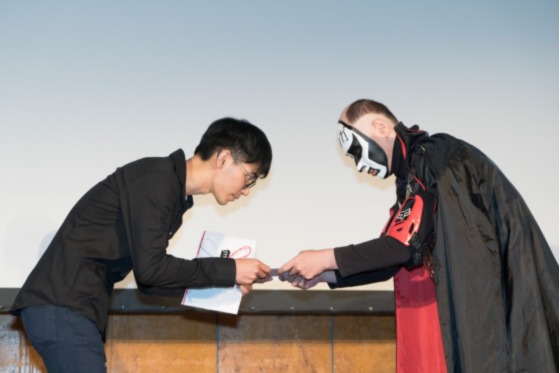KIFF Daily Report Day 4, Sunday October 15, 2017
2017/10/15 Report

Yoshimoto Creative Agency’s much-anticipated blockbuster Hibana (Spark) had its World Premiere Sunday morning October 15 at the Toho Nijo cinema. The house was packed out with not a single seat unoccupied. Director Itsuji Itao, actors Masaki Suda and Shuji Kawatani took the stage after the screening to discuss the project.
The film is based on the Akutagawa-prize winning novel by Naoki Matayoshi, which sold over 3 million copies. Matayoshi is also a famous comedian and part of the duo Peace. This experience was crucial for him to write Hibana as it is set in the Japanese comedic world of manzai, where one performer is the straight man and one the comic. The source material was also made into a 10-part Netflix TV series last year.
The plot of the film Hibana revolves around Tokunaga (Suda), an up-and-coming manzai comic who meets the older, cutting-edge performer Kamiya (Kenta Kiritani) and immediately pledges to be his devoted student. Their relationship is fraught with challenges though. Tokunaga and Kamiya don’t live in the same city and both are part of separate manzai duos. The film follows their relationship for 10 years, outlining the heartaches and battles of minor comedians in Japan as well as the challenges of friendship.
Itao, Suda and Kawatani took the stage after the screening and delighted the audience with jokes and light banter. Of the filmmaking process for Hibana Suda said, “I didn’t know how to act to present to manzai on screen but director Itao didn’t given me any instruction, he just said ‘you’re doing fine.’ So I had to figure out the timing and Shuji just told me to do what feels natural.” The director added, “You can’t explain what makes people laugh so they just had to practice doing manzai as the Sparks duo.”
Sunday afternoon at KIFF saw Former Rissei Elementary School host an important new initiative for event organizers Yoshimoto Kogyo, with the announcement of the winner of the first “Original Work Development Project.”
Complimenting the well-established Creator’s Factory for budding filmmakers, the new project is aimed at finding the best young manga, novel and non-fiction writers, and is open to Japanese and foreign applicant’s.
The Grand Prix Winner for the “MediBang!” Manga Category was announced as Dolls (Jingu) by Taiwan’s Yinfu. Selected from 463 submissions entered between April and July this year, Dolls tackles the issue of love between a parent and a child, and is centered a boy-shaped doll carved by a skilled wood craftsman, who had lost his only son.
Yusuke Tomoda, Head of Kindle Content at Amazon Japan, then took to the stage to announce the 2nd contest with Kindle Direct Publishing. The Novel Category will be open from October 16 through February 28, 2018, with a prize of 300,000 yen and consideration for publication and visual adaptation on Amazon Prime Video. Submissions can be made online at: https://www.amazon.co.jp/kindle-kdporiginalstory
Entries should be set in the real world, be entirely original and be between 10-50,000 characters long. All genres are accepted but works must be Japanese.
Storys.jp will run the Non-fiction category with an identical prize but is open to all, with submissions accepted October 16 through January 31, 2018. Submissions can be made online at: http://storys.jp/katarie
The final afternoon of the 2017 edition of KIFF saw renowned director Kaizo Hayashi screen two short films that focus on the aftermath of the Fukushima nuclear disaster. Hayashi is a legendary director who ruled the Japanese film world in the 80s & 90s. He authored such hit flicks as Circus Boys, Jinpangu and the Maiku Hamma tongue-in-cheek detective series.
The KIFF presentation was made up of two short films in a trilogy (the third is yet to be completed) about the 20-kilometer exclusion zone around the crippled Fukushima nuclear power plant. The first, Good Year, features mega-star Masatoshi Nagase as a lonely mechanic who refuses to give up his residence in the troubled area.
Dark and without much dialog, Good Year concentrates on the loneliness of the area. The mechanic’s solitude is broken when a woman, calling herself Abe Maria, in a fancy sports car gets into an accident outside his shop. He must take her and her car in, and care for the woman. His seclusion is broken up momentarily but we understand she must move on while the mechanic is tied to the contaminated land.
The second piece, Life, focuses on the death of an old man who continued to live in the evacuation zone even after the government ordered everyone out. Again, it’s a quiet work without much dialog. We are confronted with the desolate land and garbage-strewn house of the old man, exemplifying the hopelessness of life in the exclusion zone.
Kaizo Hayashi and actor Masami Horiuchi took the stage after the two pieces were screened. The director was thrilled with the screening, noting, “More people came than I thought would!” In explaining the films he said, “I concentrated most on the visual look of the films. Fukushima is such a tragedy, I’ve experienced it, and I wanted to try and convey that visually.”

- Facebook Share
- Twitter Share





